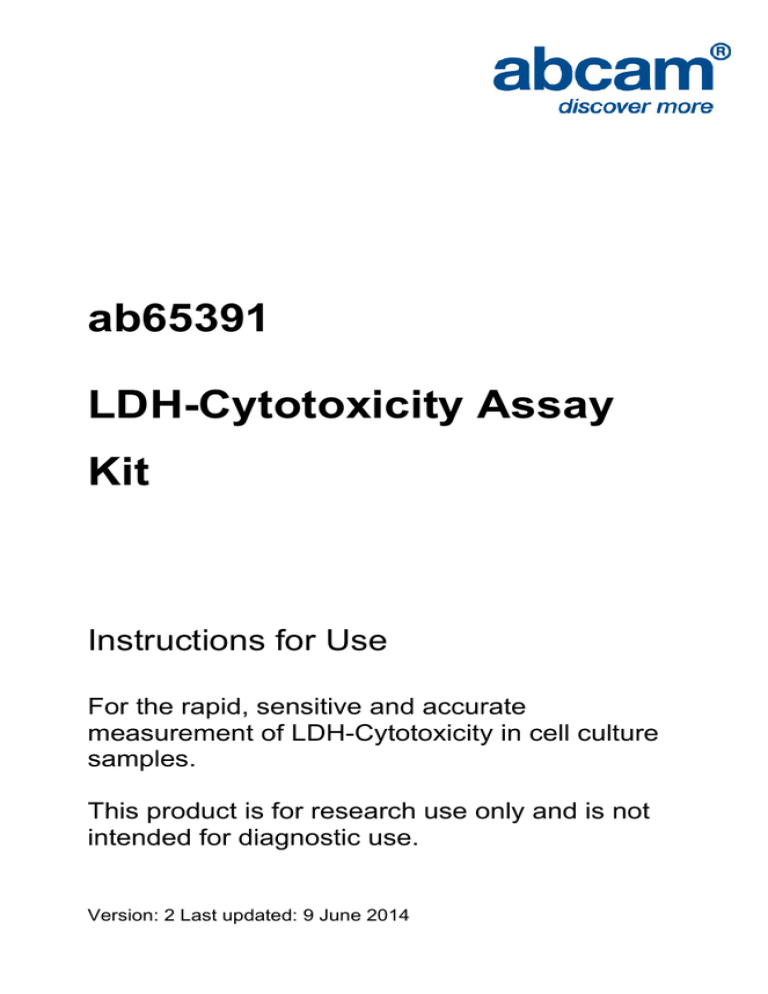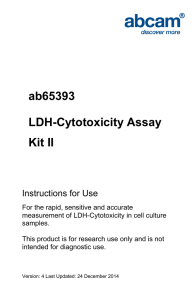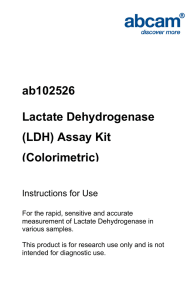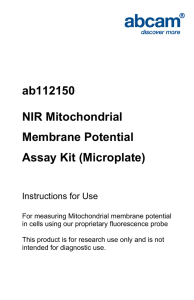ab65391 LDH-Cytotoxicity Assay Kit Instructions for Use
advertisement

ab65391 LDH-Cytotoxicity Assay Kit Instructions for Use For the rapid, sensitive and accurate measurement of LDH-Cytotoxicity in cell culture samples. This product is for research use only and is not intended for diagnostic use. Version: 2 Last updated: 9 June 2014 1 Table of Contents 1. Overview 3 2. Protocol Summary 4 3. Components and Storage 5 4. Assay Protocol 7 5. Data Analysis 9 6. Troubleshooting 10 2 1. Overview Cell death or cytotoxicity is classically evaluated by the quantification of plasma membrane damage. Abcam’s LDH-Cytotoxicity Assay Kit provides a fast and simple method for quantitating cytotoxicity based on the measurement of activity of lactate dehydrogenase (LDH) released from damaged cells. Unlike many other cytoplasmic enzymes which exist in many cells either in low amount (e.g., alkaline and acid phosphatase) or unstable, LDH is a stable cytoplasmic enzyme present in all cells and rapidly released into the cell culture supernatant upon damage of the plasma membrane. LDH activity can be determined by a coupled enzymatic reaction: LDH oxidizes lactate to pyruvate which then reacts with tetrazolium salt INT to form formazan. The increase in the amount of formazan produced in culture supernatant directly correlates to the increase in the number of lysed cells. The formazan dye is water-soluble and can be detected by spectrophotometer at 500 nm. The LDH-cytotoxicity assay is sensitive, convenient, and precise, and is applicable to a variety of cytotoxicity studies. Assay takes ~0.5-1 hr. 3 2. Protocol Summary Sample Preparation Sample Incubation Prepare and Add Reaction Mixture Measure Absorbance 4 3. Components and Storage A. Kit Components Item Catalyst (Lyophilized) Dye Solution Quantity 1 vial 45 mL * Store kit at -20°C CATALYST SOLUTION: Reconstitute the Catalyst in 1 ml ddH2O for 10 min and mix thoroughly. The Catalyst Solution is stable for several weeks at +4°C. DYE SOLUTION: After thawing, the Dye Solution is stable for several weeks at +4°C. Avoid freeze/thaw cycles. REACTION MIXTURE: For 100 assays, mix 250 μl of Catalyst Solution with 11.25 ml of Dye Solution. The mixture solution should be prepared immediately before use. 5 B. Additional Materials Required Microcentrifuge Pipettes and pipette tips Colorimetric microplate reader 96 well plate Orbital shaker 6 4. Assay Protocol 1. Collect cells (adherent and suspension) and wash 1X with assay medium (e.g., medium containing 1% serum or 1% BSA). Note: Trypsin may be used to remove adherent cells from a culture surface. 2. Prepare the following samples individually in a 96-well plate: a. Background Control: Add 200 μl medium/well into triplicate wells. The background value has to be subtracted from all other values. b. Low Control: Add 1-2 x 104 cells/well in 200 μl assay medium into triplicate wells. c. High Control: Add 1-2 x 104 cells/well in 200 μl assay medium containing 1% Triton X-100 into triplicate wells. d. Test Sample: Add 1-2 x 104 cells/well in 200 μl assay medium containing test substance into triplicate wells. 3. Incubate cells in an incubator (5 % CO2, 90 % humidity, 37°C) for the appropriate time of treatment determined for test substance. 4. Centrifuge the cells at 250 x g for 10 min. 7 5. Transfer 100 μl/well supernatant carefully into corresponding wells of an optically clear 96-well plate. 6. Add 100 μl Reaction Mixture to each well and incubate for up to 30 min at room temperature. Protect the plate from light. 7. Measure the absorbance of all samples at 490-500 nm using a microtiter plate reader. The reference wavelength should be more than 600 nm. 8 5. Data Analysis (Test Sample – Low Control) Cytotoxicity (%) = X 100 (High Control – Low Control) Light bar: Low control Dark bar: High control. Jurkat cells were cultured in 96-well plate in 100 μl of culture medium. LDH assay was performed using 10 μl of culture medium according to the kit instructions. 9 6. Troubleshooting Problem Reason Solution Assay not working Assay buffer at wrong temperature Assay buffer must not be chilled - needs to be at RT Protocol step missed Plate read at incorrect wavelength Unsuitable microtiter plate for assay Unexpected results Re-read and follow the protocol exactly Ensure you are using appropriate reader and filter settings (refer to datasheet) Fluorescence: Black plates (clear bottoms); Luminescence: White plates; Colorimetry: Clear plates. If critical, datasheet will indicate whether to use flat- or U-shaped wells Measured at wrong wavelength Use appropriate reader and filter settings described in datasheet Samples contain impeding substances Unsuitable sample type Sample readings are outside linear range Troubleshoot and also consider deproteinizing samples Use recommended samples types as listed on the datasheet Concentrate/ dilute samples to be in linear range 10 Samples with inconsistent readings Unsuitable sample type Samples prepared in the wrong buffer Samples not deproteinized (if indicated on datasheet) Cell/ tissue samples not sufficiently homogenized Too many freezethaw cycles Samples contain impeding substances Samples are too old or incorrectly stored Lower/ Higher readings in samples and standards Not fully thawed kit components Out-of-date kit or incorrectly stored reagents Reagents sitting for extended periods on ice Incorrect incubation time/ temperature Incorrect amounts used Refer to datasheet for details about incompatible samples Use the assay buffer provided (or refer to datasheet for instructions) Use the 10kDa spin column (ab93349) Increase sonication time/ number of strokes with the Dounce homogenizer Aliquot samples to reduce the number of freeze-thaw cycles Troubleshoot and also consider deproteinizing samples Use freshly made samples and store at recommended temperature until use Wait for components to thaw completely and gently mix prior use Always check expiry date and store kit components as recommended on the datasheet Try to prepare a fresh reaction mix prior to each use Refer to datasheet for recommended incubation time and/or temperature Check pipette is calibrated correctly (always use smallest volume pipette that can pipette entire volume) 11 Problem Reason Solution Standard curve is not linear Not fully thawed kit components Wait for components to thaw completely and gently mix prior use Pipetting errors when setting up the standard curve Incorrect pipetting when preparing the reaction mix Air bubbles in wells Concentration of standard stock incorrect Errors in standard curve calculations Use of other reagents than those provided with the kit Try not to pipette too small volumes Always prepare a master mix Air bubbles will interfere with readings; try to avoid producing air bubbles and always remove bubbles prior to reading plates Re-check datasheet for recommended concentrations of standard stocks Refer to datasheet and re-check the calculations Use fresh components from the same kit For further technical questions please do not hesitate to contact us by email (technical@abcam.com) or phone (select “contact us” on www.abcam.com for the phone number for your region). 12 13 14 UK, EU and ROW Email: technical@abcam.com Tel: +44 (0)1223 696000 www.abcam.com US, Canada and Latin America Email: us.technical@abcam.com Tel: 888-77-ABCAM (22226) www.abcam.com China and Asia Pacific Email: hk.technical@abcam.com Tel: 108008523689 (中國聯通) www.abcam.cn Japan Email: technical@abcam.co.jp Tel: +81-(0)3-6231-0940 www.abcam.co.jp 15 Copyright © 2012 Abcam, All Rights Reserved. The Abcam logo is a registered trademark. All information / detail is correct at time of going to print.



